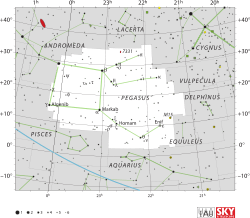Zeta Pegasi

| |
| Observation data Epoch J2000.0 Equinox J2000.0 | |
|---|---|
| Constellation | Pegasus |
| Right ascension | 22h 41m 27.72072s[1] |
| Declination | +10° 49′ 52.9079″[1] |
| Apparent magnitude (V) | +3.414[2] |
| Characteristics | |
| Spectral type | B8 V[3] |
| U−B color index | –0.181[2] |
| B−V color index | –0.088[2] |
| Variable type | SPB[4] |
| Astrometry | |
| Radial velocity (Rv) | +7.0[5] km/s |
| Proper motion (μ) | RA: +77.22[1] mas/yr Dec.: –11.38[1] mas/yr |
| Parallax (π) | 15.96 ± 0.19[1] mas |
| Distance | 204 ± 2 ly (62.7 ± 0.7 pc) |
| Details | |
| Radius | 4.03 ± 0.22[6] R☉ |
| Surface gravity (log g) | 3.67 ± 0.05[6] cgs |
| Temperature | 11,190 ± 55[6] K |
| Rotational velocity (v sin i) | 140[7]–210[8] km/s |
| Age | 120[8] Myr |
| Other designations | |
Zeta Pegasi (ζ Peg) is a single[10] star in the northern constellation of Pegasus. It has the traditional name, Homam, meaning "Man of High Spirit" or "Lucky Star of High Minded". With an apparent visual magnitude of +3.4,[2] this star is bright enough to be seen with the naked eye and is one of the brighter members of Pegasus. Parallax measurements place it at a distance of around 204 light-years (63 parsecs) from Earth.[1]
This star has a stellar classification of B8 V,[3] which identifies it as a large B-type main sequence star that is generating energy through the nuclear fusion of hydrogen at its core. The radius of this star is about four times that of the Sun.[6] It is a slowly pulsating B star that varies slightly in luminosity with a period of 22.952 ± 0.804 hours, completing 1.04566 cycles per day.[4] Zeta Pegasi is about 120[8] million years old and is rotating rapidly with a projected rotational velocity in the range of 140[7]–210[8] km s−1. The effective temperature of its outer envelope is around 11,190 K,[6] giving it the characteristic blue-white glow of a B-type star.[11]
Zeta Pegasi has been examined for infrared excess that may indicate the presence of circumstellar matter, but none was found.[12] This star does have two optical companions. The first is a magnitude 11.6 star at an angular separation of 68 arcseconds along a position angle of 139°, as of 1997.[4] The second is an 11th magnitude star at a separation of 177 arcseconds with a position angle of 5°.[5] Zeta Pegasi is not known to be a member of a stellar association.[12]
References
- ↑ 1.0 1.1 1.2 1.3 1.4 1.5 van Leeuwen, F. (November 2007), "Validation of the new Hipparcos reduction", Astronomy and Astrophysics 474 (2): 653–664, arXiv:0708.1752, Bibcode:2007A&A...474..653V, doi:10.1051/0004-6361:20078357
- ↑ 2.0 2.1 2.2 2.3 Gutierrez-Moreno, Adelina et al. (1966), A System of photometric standards 1, Publicaciones Universidad de Chile, Department de Astronomy, pp. 1–17, Bibcode:1966PDAUC...1....1G
- ↑ 3.0 3.1 Palmer, D. R. et al. (1968), "The radial velocities spectral types and projected rotational velocities of 633 bright northern A stars", Royal Observatory Bulletin 135: 385, Bibcode:1968RGOB..135..385P
- ↑ 4.0 4.1 4.2 Goebel, John H. (May 2007), "Gravity Probe B Photometry and Observations of ζ Pegasi: An SPB Variable Star", The Publications of the Astronomical Society of the Pacific 119 (855): 483–493, Bibcode:2007PASP..119..483G, doi:10.1086/518618
- ↑ 5.0 5.1
- ↑ 6.0 6.1 6.2 6.3 6.4 Fitzpatrick, E. L.; Massa, D. (March 2005), "Determining the Physical Properties of the B Stars. II. Calibration of Synthetic Photometry", The Astronomical Journal 129 (3): 1642–1662, arXiv:astro-ph/0412542, Bibcode:2005AJ....129.1642F, doi:10.1086/427855
- ↑ 7.0 7.1 Abt, Helmut A.; Levato, Hugo; Grosso, Monica (July 2002), "Rotational Velocities of B Stars", The Astrophysical Journal 573 (1): 359–365, Bibcode:2002ApJ...573..359A, doi:10.1086/340590
- ↑ 8.0 8.1 8.2 8.3 Rieke, G. H. et al. (February 2005), "Decay of Planetary Debris Disks", The Astrophysical Journal 620 (2): 1010–1026, Bibcode:2005ApJ...620.1010R, doi:10.1086/426937
- ↑ "zet Peg -- Star in double system", SIMBAD Astronomical Object Database (Centre de Données astronomiques de Strasbourg), retrieved 2012-03-01
- ↑ Roberts, Lewis C., Jr.; Turner, Nils H.; ten Brummelaar, Theo A. (February 2007), "Adaptive Optics Photometry and Astrometry of Binary Stars. II. A Multiplicity Survey of B Stars", The Astronomical Journal 133 (2): 545–552, Bibcode:2007AJ....133..545R, doi:10.1086/510335
- ↑ "The Colour of Stars", Australia Telescope, Outreach and Education (Commonwealth Scientific and Industrial Research Organisation), December 21, 2004, retrieved 2012-01-16
- ↑ 12.0 12.1 Su, K. Y. L. et al. (December 2006). "Debris Disk Evolution around A Stars". The Astrophysical Journal 653 (1): 675–689. arXiv:astro-ph/0608563. Bibcode:2006ApJ...653..675S. doi:10.1086/508649.
| ||||||||||||||||||||||||||||||||||